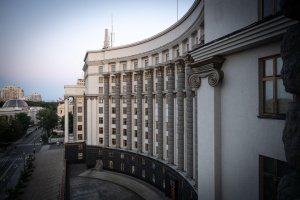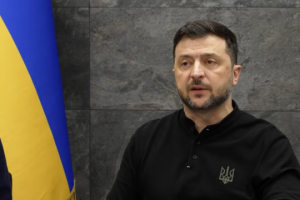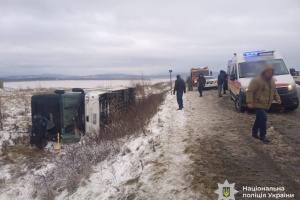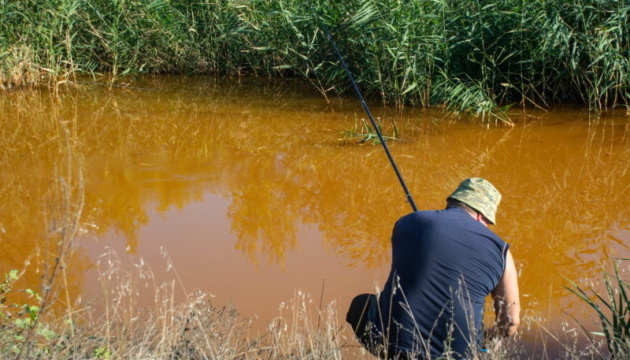
Remember everything: destruction of Ukraine's environment by Russians began in 2014
However, we should not forget that the war and related environmental problems began in 2014.
The Center for Strategic Communications and Information Security reminds of the environmental problems of Ukraine created by the aggressor even before the full-scale invasion.
Flooding of mines in eastern Ukraine
One of the main problems after Russia unleashed hostilities in eastern Ukraine, with its industrial zone, in particular, chemical enterprises, was the flooding of mines. Many mines in the occupied areas of Luhansk and Donetsk regions have stopped pumping water.
As part of the project of the French humanitarian organization ACTED, as reported by "Radio Svoboda", 20 samples of groundwater were taken in the city of Toretsk and the surrounding mines - mine water, from wells and from wells. Only two of the twenty samples were close to drinking water standards. At the same time, mine water contained toxic elements whose concentration exceeds the permissible levels even for domestic water. The water and soil analysis was carried out by specialists of the state enterprise "Donetskgeologiia". They found that further flooding of the mines in the area could lead to, among other things, the release of mine water with high mineralization over an area of 1,400 hectares, which would lead to waterlogging and salinization of the soil, as well as deterioration of groundwater quality.
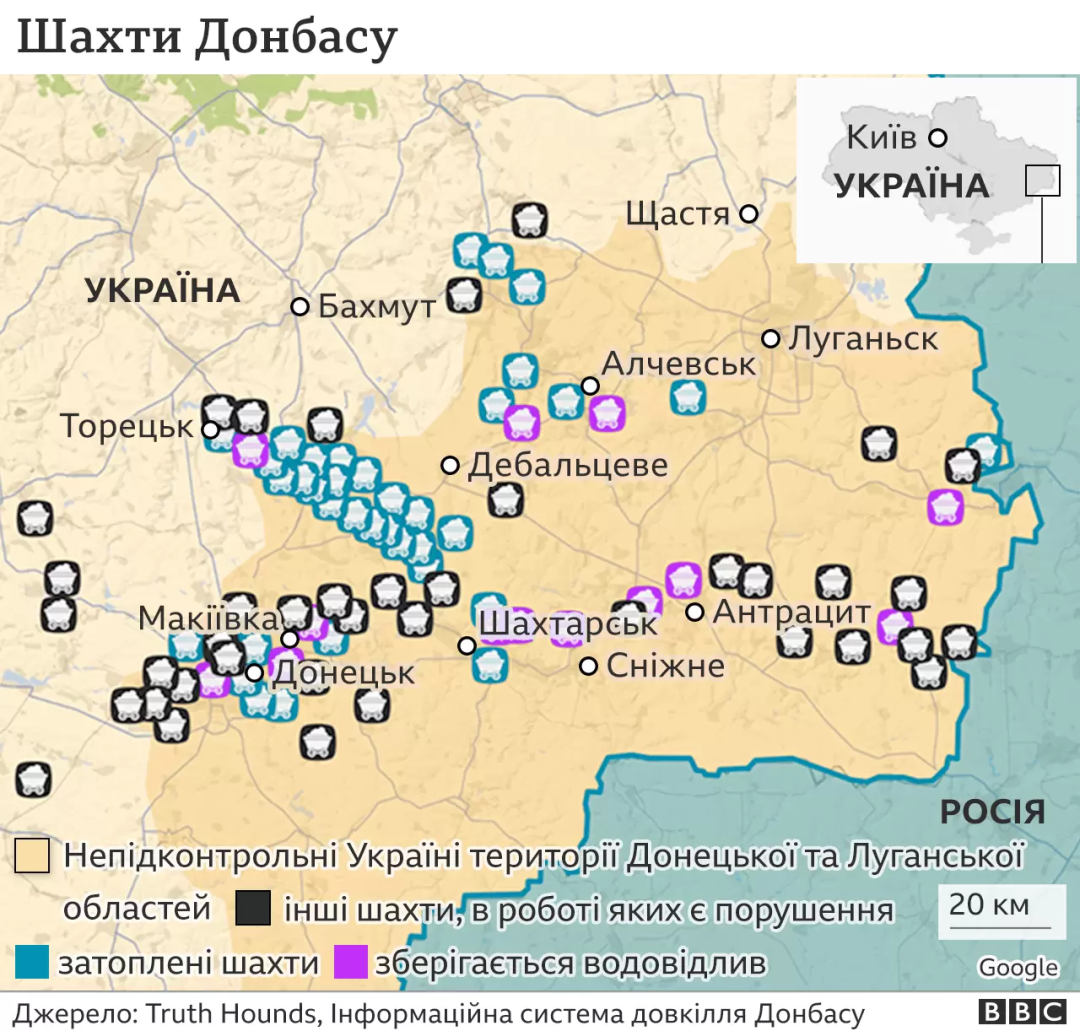
Among other things, the "Yunyi Komunar" mine was flooded, where an experimental underground nuclear explosion was conducted in 1979. Since 2014, this mine, located near the village of Bunge, has been under Russian occupation. Water drainage was stopped on April 14, 2019, without the consent of the IAEA and the State Nuclear Regulatory Inspectorate of Ukraine (SNRIU). The facility was transferred from dry to wet mothballing.
Radioactivity in mine workings and mine waters during the period of observation in 1979-2000 was at the background level, but the flooding creates new risks. According to the Ministry of Environmental Protection and Natural Resources of Ukraine, the cessation of water drainage threatens to release artificial radionuclides that may be contained in the capsule: strontium-137, cesium-90, and plutonium-239.
In addition, the release of radioactive liquid into the groundwater threatens to contaminate the Azov Sea ecosystem. The conservation option chosen by the Russian occupation administration is environmentally hazardous, as it can lead to repeated contamination with radionuclides.
Roman Filonenko, Head of the Department for Waste Management and Environmental Safety, told the Center for Strategic Communications that since 2014, Ukraine has been raising the issue of underwater and soil pollution in the OSCE-mediated Trilateral Contact Group for Peaceful Settlement. However, representatives of Russia and the puppet administrations of the so-called "DPR" and "LPR" blocked Ukraine's attempts to introduce environmental monitoring of the occupied territories under various pretexts, denying access to Ukrainian and international experts.
Only when groundwater flooded the mines of the occupied territories and brought contaminated mineralized water to the territory of the Russian Federation, and water quality in the wells of the Rostov region deteriorated significantly, did the Russians agree to allow international experts to visit. However, after the full-scale invasion began, this issue was put on hold.
Another idea promoted by Ukraine in the Trilateral Contact Group was the creation of a number of "safety islands" around hazardous enterprises. For example, at the Coke Plant, the Donetsk State-Owned Chemical Plant, or the "Stirol" Concern. Experts would have to appear there to conduct an audit, and a more substantial withdrawal of troops would have to be carried out in the area around them to reduce shelling and avoid emergencies. This initiative was also rejected by the Russian side.
Emissions at the "Crimean Titan"
While the OSCE worked in the occupied east of Ukraine, and the special monitoring mission performed at least some functions, the Russians did not allow anyone to enter the occupied Crimea, emphasizing that this peninsula was exclusively an internal affair of the Russian Federation.
However, the occupiers were unable to hide the environmental problems they created from the world. Thus, in August and September 2018, emissions of toxic substances from the acid storage facility at the "Crimean Titan" enterprise in the city of Armyansk were recorded. On August 31, 2018, the State Ecological Inspectorate near the administrative border of Kherson region with Crimea detected twice the normal concentration of sulfates in the soil. The occupation administration announced the evacuation of children from Armyansk only 18 days after the first release.
In March 2019, another massive release of a toxic substance occurred at the plant's acid storage facility, which was under a layer of phosphogypsum and a "water lock." According to local residents, there was a strong evaporation of chemicals in the area of the acid storage facility, which was carried by the wind to residential areas of Armyansk and surrounding settlements. The plant's employees were provided with respiratory protection equipment during their shifts.
A similar emission occurred in August 2019. At that time, the occupation authorities of Crimea concealed the fact of chemical emissions. Each of the cases was accompanied by a sharp deterioration in the health of local residents. Massive hospitalizations of residents of the occupied Dzhankoy and Krasnogvardeysk districts were recorded; in 2019, there were numerous cases of births of children with developmental disabilities.
According to environmentalists from the "Ecology Law and Human Rights" (ELHR), the cause of the 2018 pollution was a sedimentation pond where waste from the plant's sulfur shop, including waste sulfuric acid, was stored. The storage pond was supposed to be irrigated with water every day, as regular watering is important for the safe maintenance of the sump. However, the plant's administration did not take care of this water supply.
Drying out of the pond is the evaporation of water from the solution and the release of sulfur dioxide into the air, which is an acid gas and can form an acid again when it comes into contact with water. This happens through a reaction with water droplets in fog, with dew on the surface of plants, with sweat droplets on human skin, or with the mucous membranes of the eyes, nose, mouth, trachea, and bronchi.
People in the areas contaminated by the accident complained of respiratory problems, eye problems, and allergic reactions. Residents of Armyansk and the village of Perekop in Crimea, as well as the village of Preobrazhenka in Kherson region, were primarily affected. Ukrainian border guards on the isthmus have also sought medical help.
In addition to affecting human health, the acidic environment also has a negative impact on the environment. Plants receive chemical burns and soon die or dry out. Most of the crops in the above-mentioned areas have been contaminated and lost.
Soil contaminated by shells and burned forests
Another environmental problem since 2014 has been the contamination of soil after being hit by mine and shell fragments. ELHR ecologists believe that it is impossible to grow crops for food production in the areas of shell explosions, as heavy metals and sulfur compounds get into the craters. In the explosion craters examined, elevated concentrations of cadmium, lead, nickel, zinc, chromium, cobalt, copper, vanadium, titanium, manganese, strontium, iron, zirconium, tin, gallium, and yttrium were found.
For example, in 2018, ecologists investigated the location of the largest concentration of craters (over 15,000) in fields in the vicinity of the village of Savurivka in Donetsk Oblast, where at least 10 tons of sulfur alone got into the soil. According to ELHR's experts, at least 225 square kilometers in the Savur-Mohyla battlefield have become unusable for agriculture.
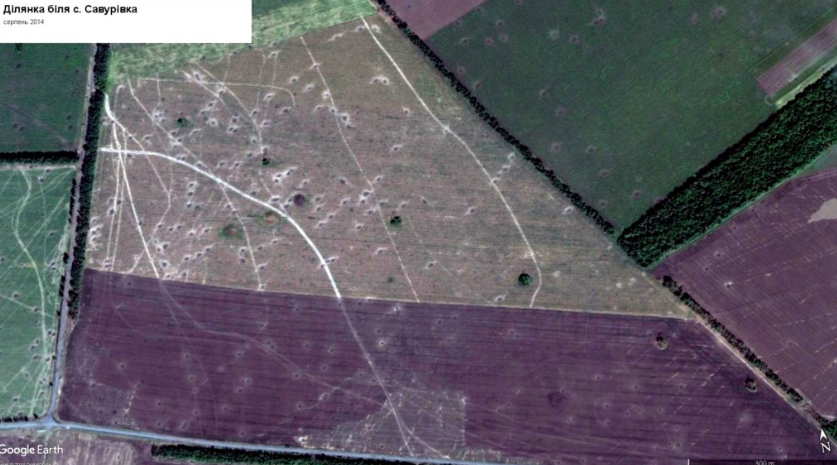
Another problem is the destruction of protected forests by the war. According to ELHR, only in 2014, during the battles for Sloviansk, about 1000 hectares of the "Holy Mountains" National Nature Park were damaged by fire from "grad" shelling. At that time, the fire covered about half of the area of regional landscape parks, of which at least 50% were forests (up to 1800 hectares).
"The damage to the protected areas we have identified is caused by three main factors: shelling, heavy equipment passages and fires caused by ammunition explosions and deliberate arson," explains ELHR ecologist Oleksii Vasylyuk.
According to the Resolution of the Cabinet of Ministers of Ukraine No. 541 of July 24, 2013, a fee schedule was approved to calculate the amount of damage caused by violation of the legislation on the nature reserve fund. According to it, ELHR estimates that as of November 3, 2014, the amount of damage caused by the war-destroyed protected forests alone amounted to UAH 13.9 million.
At the end of 2021, the Ministry of Environmental Protection and Natural Resources of Ukraine launched an initiative to international organizations, including UNEP, UNDP, and UNIDO, with a proposal to develop methods for assessing the damage caused to Ukraine's environment by Russian aggression to prepare claims for recovery. At the time, the Ukrainian side's position was not understood, and some organizations expressed theses in their letters that could be perceived as playing along with the aggressor country, Russia.
Soon after, Russia's full-scale invasion began and the amount of damage to the Ukrainian environment increased many times over.
Center for Strategic Communications and Information Security

